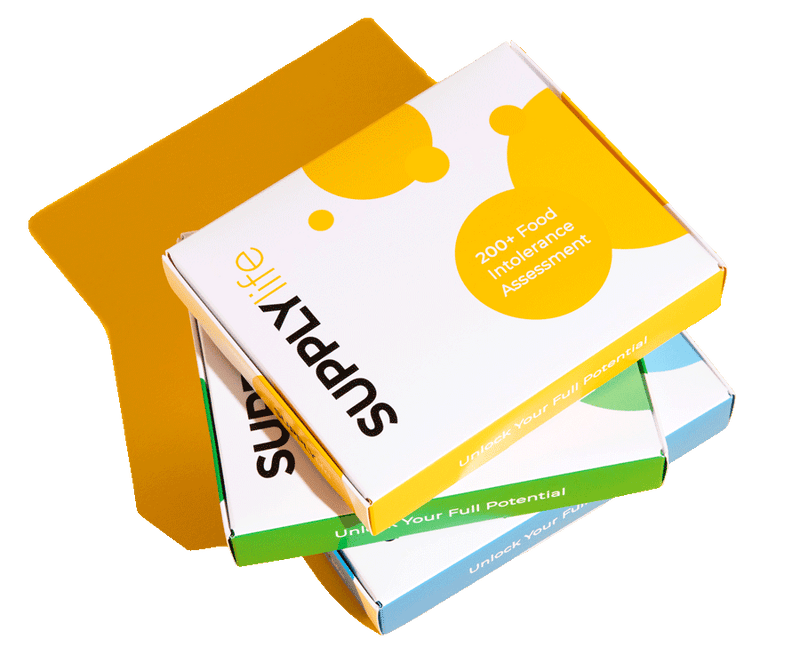Jump to Section
Table of Contents
- What Is Lactose Intolerance?
- Understanding Lactose and Lactase
- Dairy Intolerance vs Milk Allergy vs Lactose Intolerance
- Symptoms of Lactose Intolerance
- Types of Lactose Intolerance
- Causes and Risk Factors
- Diagnosing Lactose Intolerance
- Managing Lactose Intolerance
- Nutritional Considerations
- Emerging Research and Future Directions
- FAQs
- Conclusion
Lactose Intolerance
Written by:
 Riya Lakhani-Kanji, MSc, ANutr. Last Reviewed 1st January 2025.
Riya Lakhani-Kanji, MSc, ANutr. Last Reviewed 1st January 2025.
Many people believe they can't digest lactose, which is the sugar naturally found in milk and dairy products. And as it turns out, they’re mostly correct, as most individuals—especially those over the age of two—really do have trouble with lactose. Experts estimate that about 68% of the world’s population has some level of lactose intolerance, making it a common issue. This raises an important question — what exactly is lactose intolerance, and why is it so widespread?

What Is Lactose Intolerance?
Lactose intolerance is a condition in which the body has difficulty digesting lactose, a type of sugar primarily found in dairy products such as milk, cheese, and yogurt. This happens when the small intestine doesn't make enough of an enzyme called lactase, which is what helps break down lactose so the body can properly absorb it.
When lactose is not fully digested in the small intestine, it moves on to the large intestine. There, bacteria try to break it down, but this process is only partially effective. As a result, the fermentation of undigested lactose produces gases and acids, leading to uncomfortable symptoms such as excessive gas, bloating, and stomach pain.
Lactose intolerance often begins in childhood or early adulthood. While babies typically have high levels of the enzyme lactase to help them digest lactose, their bodies may produce less of it as they grow older. Interestingly, some infants can be lactose intolerant from birth.
In the UK, it is estimated that about one in ten older children and adults may experience lactose intolerance. However, the prevalence can differ significantly among various ethnic groups. For instance, individuals of African, Asian, Hispanic, and Native American descent tend to experience higher rates of lactose intolerance compared to other populations.
Understanding and managing lactose intolerance is key to maintaining a healthy digestive system and feeling your best. When people realise they are lactose intolerant, it helps them connect the dots about why they may feel uncomfortable after eating certain foods, particularly dairy products like milk, cheese, and yogurt. This awareness can make a big difference in how they choose to eat and how they feel afterwards.

Understanding Lactose and Lactase
Lactose is a type of sugar made up of two simpler sugars called glucose and galactose. In foods like milk, cheese, yogurt, and butter, lactose affects sweetness, texture, and even how they brown during cooking or baking. For example, in ice cream, lactose helps create the creamy texture that people enjoy.
In cheese, lactose is broken down by bacteria during fermentation, producing lactic acid. This process gives cheese its flavour and texture. For aged cheeses, the lactose content is reduced, which can make them easier to digest for people who are lactose intolerant.
Lactose also helps in making cultured dairy products like yogurt. In this case, it acts as food for good bacteria, which ferments the milk into yogurt and often lowers the lactose content, making the yogurt easier for many people to digest.
When we consume lactose, our bodies must break it down into its simpler sugars, glucose and galactose, to be effectively absorbed into the bloodstream. This is where an enzyme called lactase comes in. Produced in the small intestine, lactase helps break down lactose into these simpler sugars.
Once lactose is broken down by lactase, glucose and galactose are absorbed through the walls of the small intestine and enter the bloodstream, providing your body with energy.
However, if you don’t have enough lactase, your body can’t properly break down lactose. Instead of being processed, the lactose ends up in your colon. There, it interacts with bacteria, which leads to uncomfortable symptoms like bloating, gas, and diarrhea. This is what's known as lactose intolerance, and it happens when your system struggles to digest dairy properly.

Dairy Intolerance vs Milk Allergy vs Lactose Intolerance
The term "dairy intolerance" is often used as a catch-all phrase that refers to both lactose intolerance and milk allergy. While both conditions involve dairy products and can lead to uncomfortable symptoms, it’s important to understand that they are distinct.
A milk allergy is an immune system reaction that occurs when the body mistakenly identifies certain proteins in milk as harmful substances. This leads to an allergic response whenever dairy is consumed. The most common type of milk allergy occurs in response to cow's milk, with the proteins casein and whey being the primary triggers. However, some individuals may also be allergic to milk from other animals, such as goats, sheep, and buffalo.
On the other hand, lactose intolerance occurs when the body lacks the enzyme lactase, which is necessary for digesting lactose. This deficiency can result in gastrointestinal symptoms such as bloating, diarrhoea, and gas. These symptoms are generally linked to digestive problems and do not involve the immune system.
The symptoms of a milk allergy can manifest in two main types: immediate and delayed. When someone has an immediate reaction, known as IgE-mediated milk allergy, their body releases a substance called Immunoglobulin E (IgE) shortly after consuming milk. This can lead to symptoms like hives, swelling, itching, coughing, wheezing, and even difficulty breathing, all of which can manifest within just minutes. On the other hand, the delayed type, called non-IgE mediated milk allergy, is more common and results in symptoms that appear anywhere from two hours to three days after milk consumption. Because the symptoms of delayed reactions can look a lot like those of lactose intolerance, they are often confused with each other. Understanding these differences is important for getting the right treatment and reducing symptoms effectively.
It's important to note that in some cases, a milk allergy can cause a severe reaction known as anaphylaxis, which can make it hard to breathe, affect heart rhythm, or lead to a dangerous drop in blood pressure, requiring immediate medical help.
Symptoms of Lactose Intolerance
If you're lactose intolerant, you might start to notice symptoms between 30 minutes and 2 hours after eating or drinking something with lactose. These symptoms can last as the lactose moves through your digestive system, which usually takes between 24 to 72 hours.
Common symptoms of lactose intolerance include:
- Bloating (feeling full or swollen in the stomach)
- Pain or cramps in the abdomen
- Rumbling noises from the stomach
- Diarrhoea
- Increased gas (flatulence)
- Feeling sick or being sick
- Unusual tiredness
- Aches in joints and muscles
- Finding it hard to concentrate
- The severity of these symptoms can vary, depending on how much lactose you consume.
Types of Lactose Intolerance
There are four main types of lactose intolerance, each caused by different factors:
Primary Lactose Intolerance
Primary lactose intolerance is the most common form of lactose intolerance, and it tends to develop as people grow older. Newborns have high levels of lactase. However, as they start to eat different foods, their bodies often produce less of this enzyme. This decrease in lactase can make it harder to digest lactose, leading to symptoms like bloating or gas.
Generally, persistent lactose intolerance is rare in children under the age of 3, and it typically doesn’t become noticeable until around age 8. Most individuals begin to realise they have trouble digesting dairy during their teenage years or adulthood, as the natural decline in lactase production makes it increasingly difficult to process dairy products. This condition is more commonly observed in individuals with Asian, African, and Hispanic backgrounds.
Secondary Lactose Intolerance
Secondary lactose intolerance can occur at any age, and is usually triggered by health issues or factors affecting the small intestine. Conditions like gastroenteritis, coeliac disease, and inflammatory bowel disease can cause inflammation or damage in the gut, which reduces the amount of lactase. Also, surgeries involving the small intestine or certain medications can even affect how the gut functions, leading to lactose intolerance.
What makes secondary lactose intolerance unique is that it is often temporary. The drop in lactase production usually happens because of the gut's condition, not because of a permanent issue. Once the underlying health problem is treated and the gut heals, normal lactase levels can return, and symptoms usually improve. Many people notice relief from lactose intolerance symptoms within 48 hours of removing lactose from their diet.

It's essential to keep an eye on the symptoms of the underlying health condition. As you manage that condition, you may also see a decrease in lactose intolerance symptoms. This shows how important it is to treat the root cause, rather than just the symptoms. By helping the gut recover, many individuals may be able to enjoy dairy again without discomfort, allowing for a more balanced diet.
Congenital Lactase Deficiency
Congenital Lactase Deficiency is an extremely rare genetic disorder. This means that babies are born with little or no lactase, which is of course essential for digesting lactose found in breast milk and regular formula. As a result, when they consume lactose, it doesn’t get digested and stays in their intestines. This leads to bacterial fermentation of the undigested lactose, producing lactic acid and hydrogen, which can cause severe diarrhoea very early in life.
Because of these digestive issues, there is a significant risk of dehydration and weight loss in affected newborns. In the first few days after birth, it's crucial to monitor their hydration and weight closely. Quick medical help is needed, and doctors usually recommend starting a lactose-free infant formula to prevent these problems. Once lactose is removed from their diet, these babies can thrive and develop normally, as long as their nutritional needs are met in other ways.
Developmental Lactose Intolerance
Developmental lactose intolerance is a temporary condition that affects preterm babies born before the 34th week of pregnancy. It happens because their small intestines are not fully developed, leading to lower levels of lactase. Since premature infants rely heavily on milk for their nutrition, this intolerance can make feeding them more challenging.
As the baby grows and their digestive system matures, they typically start producing more lactase, which helps them digest lactose better.

Causes and Risk Factors
Genetic Predisposition
Lactose intolerance is mainly affected by our genes, particularly a gene called LCT. This gene is crucial as it helps produce lactase. The LCT gene gets copied from DNA to something called messenger RNA (mRNA), which then helps create the lactase enzyme in our small intestine. But if there are any changes or mutations in the LCT gene, that process can get knocked off course, resulting in less lactase being produced. This leads to difficulty digesting lactose, causing the uncomfortable symptoms that people with lactose intolerance often experience.
Ethnic and Racial Factors
Now, let’s talk about how ethnicity and race come into play. It turns out that lactose intolerance is more common in certain groups. Studies show that people with African, Asian, Hispanic, and Native American backgrounds are generally more likely to be lactose intolerant compared to those of Northern European descent.
Why is that? Well, it’s largely about historical diets. In many non-European cultures, dairy products just weren’t a big part of the diet, so over time, these populations didn’t develop a strong genetic need to keep producing lactase as they got older.
On the other hand, people from Northern European backgrounds have been consuming dairy for a long time. Because of this long history, they’ve developed genetic traits that allow them to continue producing lactase into adulthood. This means they usually digest lactose without any issues. So, it all boils down to a mix of genetics and lifestyle that shapes how well different groups can handle lactose.
Age-Related Decline
As we get older, our bodies change in many ways, one of which is that we produce less lactase. Because of this decrease in lactase, many people start to have trouble digesting dairy.
This is a normal part of ageing and happens to many people. Research shows that our ability to digest lactose usually decreases after childhood, and some groups of people experience this change more than others due to genetics and eating habits.
Underlying Health Conditions
Certain underlying health conditions can also impact lactase production. Diseases that harm the small intestine, like celiac disease and Crohn's disease, can damage the lining where lactase is made. This damage can lead to a type of lactose intolerance that happens because of these conditions. Additionally, treatments like chemotherapy can also impact the intestinal lining and reduce lactase production, making it harder for people to digest lactose.

Diagnosing Lactose Intolerance
If you suspect that you have lactose intolerance, it's important to seek professional advice from your GP. They can provide an accurate diagnosis and help rule out other issues affecting your digestive health.
If your doctor thinks you could be lactose intolerant, they will evaluate your symptoms and how you feel after reducing dairy in your diet. To confirm the diagnosis, they may perform one or more of the following tests:
Hydrogen Breath Test: You will drink a liquid with a lot of lactose. Then, the doctor will check the hydrogen in your breath several times. If there’s a lot of hydrogen, it means you aren’t digesting lactose well.
Lactose Tolerance Test: Lactose tolerance tests measure your body's ability to break down lactose. You will drink a lactose-rich liquid, and then two hours later, the doctor will take a blood sample to see your glucose levels. If the glucose doesn’t increase, it means your body is not breaking down the lactose properly.
Stool Acidity Test: This test is mostly for babies and young children. It looks at the acid levels in their poop. If a child has trouble digesting lactose, their stool will show higher amounts of lactic acid, glucose, and other fatty acids.
In addition to the tests, your doctor might suggest an elimination diet. This means you stop eating dairy products for up to 6 weeks to see if your symptoms get better. While you’re doing this, pay attention to how you feel and any changes in your symptoms. This can help determine if you have lactose intolerance and guide your dietary choices.
After the elimination period, you can slowly start adding dairy back into your diet to see if your symptoms come back. This can help confirm whether you have lactose intolerance.
At Supply Life, we really want to help you get the answers you’re looking for when it comes to food sensitivities. Our food intolerance tests can help you uncover lactose intolerance, in a simple way. We test for the following Casein, Milk (Buffalo), Milk (Cow), Milk (Goat) and Milk (Sheep). We also test for Almond, Brazil Nut, Coconut,Flax Seed, Pine Nut, Cashew Nut, Pistachio, Rapeseed, Macadamia Nut, Tiger Nut, Hazelnut, Sesame Seed, Peanut, Sunflower Seed and Walnut. This will help identify if you have any potential issues with milk alternatives. With this information, you can easily adjust your meals to fit your personal needs and feel your best.

Unlock your full potential today
Get your easy to use food intolerance test today

Managing Lactose Intolerance
Most of the time, you can manage lactose intolerance by adjusting your diet to limit or avoid foods and drinks that have lactose. Some people can handle a little lactose and just need to cut back on it, while others may need to completely avoid it.
Lactose Reduced Diet
A lactose-reduced diet lets you enjoy some dairy while cutting back on lactose. You can do this by choosing aged cheeses like cheddar, Swiss, and Parmesan, which have lower lactose levels because the lactose breaks down over time.
Fermented dairy products like yogurt and kefir are also good options, as they contain probiotics that help digest lactose. Start by eating small amounts of dairy to see how your body reacts, and gradually increase them if you tolerate it well.
Lactose-Free Alternatives
Mixing lactose-containing foods with lactose-free alternatives can also help reduce your overall lactose intake. Be mindful to limit high-lactose foods like whole milk and soft serve ice cream, and opt for lactose-free options when possible.
Many brands offer lactose-free milk, which has the same creamy texture and taste as regular milk, but without the lactose. You can also find lactose-free yogurt and cheese, providing the same nutritional benefits without the discomfort.
If you prefer plant-based options, consider almond, soy, coconut, or oat milk as delicious alternatives to dairy. These come in various flavours and work well in cooking or smoothies.
For yogurt, try options made from almond, coconut, or cashew, which often contain live probiotics. Plant-based cheeses made from nuts or soy are also available and can enhance your dishes.
For dessert, coconut, almond, or cashew milk ice creams and naturally lactose-free sorbets provide tasty options without lactose.
Lactase Supplements
Lactase enzyme supplements come in tablets or drops and are a handy option for people with lactose intolerance. You can find them at health stores and pharmacies, with popular brands like Milkaid.
Using these supplements is simple. Just take the tablets with the first bite of any meal or drink containing dairy. This can help your body break down lactose and make digestion easier. You can also add lactase drops to milk, allowing you to enjoy it without discomfort.
However, keep in mind that not everyone finds relief with these supplements. Some people may benefit greatly from them, while others might not notice much difference. It could take some experimenting to see if they work for you.
Try Probiotics
Probiotics might be worth considering as well. These "good" bacteria naturally live in your gut and aid in breaking down food, including lactose. So taking a probiotic supplement may help reduce those uncomfortable symptoms that come with lactose intolerance.
Research points to strains like Lactobacillus acidophilus and Bifidobacterium longum as particularly effective for breaking down lactose. By boosting the number of lactase-producing bacteria in your gut, probiotics can help make dairy a bit easier to handle, leading to less bloating and fewer digestive issues.
In a study from 2021, researchers looked at a group of 55 people with lactose intolerance. They found that those who ate yogurt with probiotics had fewer issues compared to those who had yogurt without. It’s rather interesting because this aligns with results from several other studies that support the idea that probiotics, especially those like acidophilus and Bifidobacterium, can help ease lactose intolerance symptoms.
Incorporating probiotics into your daily routine can be really easy. You could go for foods rich in probiotics, like yogurt with live cultures, kefir, or even fermented foods like sauerkraut and kimchi. Probiotic supplements are also a great option to ensure you’re getting enough of those beneficial bacteria.
Remember, everyone's body reacts differently to dietary changes. What works for one person might not be as effective for another. So, you might need to do a bit of experimenting to find the right strain and dosage for you. And of course, it's always a good idea to chat with your GP for guidance tailored to your situation.
Read Food Labels
One of the best ways to manage lactose intolerance is by learning how to read food labels. This helps you spot hidden sources of lactose that you might not notice right away. Here are some helpful tips to remember when you’re out for your next food shop:

1. Look for “Contains Milk”: Many packaged foods list allergens. If it says “Contains Milk,” that means the product has lactose in it.
2. Watch for Dairy Ingredients: Be on the lookout for ingredients like whey, curds, milk by-products, dry milk solids, and non-fat dry milk powder, as these can all contain lactose.
3. Avoid “Creamy” or “Rich” Descriptions: Foods that are described as creamy or rich often contain added milk or cream, which might mean they have more lactose unless it says otherwise.
4. Check for Lactase-Added Products: Some foods might have added lactase, which helps people with lactose intolerance digest them better.

Nutritional Considerations
Managing lactose intolerance often means rethinking your eating habits, especially when it comes to getting enough calcium and vitamin D. Those with lactose intolerance might face a higher risk of deficiencies in these nutrients, but there are plenty of delicious options to meet your needs.
To ensure you’re getting enough calcium and vitamin D, focus on non-dairy sources. Leafy greens like kale and bok choy are fantastic choices to boost your calcium intake. Fortified plant-based milks, such as almond, soy, or oat milk, are excellent alternatives that are often enriched with calcium and vitamin D. For those who consume fish, options like salmon and sardines are rich in vitamin D, but there are also plant-based sources like mushrooms exposed to sunlight.
Maintaining a balanced diet while managing lactose intolerance goes beyond just avoiding dairy. It’s about creating a diverse menu full of nutrients essential for your overall health. Incorporate plenty of whole grains, legumes, nuts, seeds, and a vibrant variety of fruits and vegetables into your meals. By making these thoughtful choices and paying attention to your nutrition, you can thrive on a lactose-free diet without compromising your health.
Customer Review: Liam’s Journey to Improved Health
Liam's review on Trustpilot shares his difficult experience with lactose intolerance. For eight years, he struggled with pain after eating, saying, "no matter what I ate, I would suffer with gas, a bloated belly with light to severe cramping." This pain was so bad that he was sometimes “rushed to A+E.”
After consulting three different doctors and investing a significant amount in private healthcare, Liam finally received the diagnosis he needed: lactose intolerance. This revelation brought him immense relief, and he encourages others experiencing similar symptoms to seek testing.
Liam thanked Supply Life for helping him figure out what was wrong. He says, "I can’t thank Supply Life enough in confirming what’s wrong with me and the after support!" Now, six weeks into a new dietary regimen, Liam feels more like himself again. His story highlights the importance of understanding our health and getting help when needed.
Emerging Research and Future Directions
Researchers are making good progress in finding ways to treat lactose intolerance, which is great news for the future. One exciting approach they’re exploring is lactase gene therapy. This method aims to tackle the root cause of lactose intolerance by changing the genes that are responsible for producing lactase, the enzyme needed to digest lactose.
In a clinical study, researchers used a harmless version of a virus that naturally lived in rats' guts. They modified this virus so that it carried the gene that produces lactase.
Then, they gave this modified virus to lactose-intolerant rats through a tube. After just one dose, the rats’ intestines were able to produce lactase for up to six months! This happened because the gut cells took in the gene from the virus and made it part of their own DNA, allowing them to produce the enzyme.
Overall, this gene therapy has the potential to allow the body to naturally produce the necessary enzyme for lactose digestion, possibly providing a long-lasting solution for those affected by lactose intolerance.
Another promising area of research is focused on RP-G28, a unique type of sugar that may enhance lactose digestion by promoting the growth of beneficial bacteria capable of breaking down lactose in the colon.
In one study involving 85 people with lactose intolerance, researchers gave half of these people RP-G28 and the other half a placebo for 35 days. After this period, everyone started eating dairy products, and researchers monitored them for another 30 days to see how well they could digest lactose and if their symptoms improved.
The results showed that those who took RP-G28 had better lactose digestion and less severe symptoms, especially abdominal pain. In fact, about half of the people who originally reported abdominal pain said they felt none after the treatment and a month later. Additionally, those who took RP-G28 were six times more likely to say they could tolerate lactose after reintroducing dairy into their diets.
This emerging research offers hope for individuals struggling with lactose intolerance. By exploring innovative therapies, scientists aim not just to reduce symptoms, but to address the underlying causes of lactose intolerance.
Advancements in Lactose-Free Dairy Production
As more people look for lactose-free options, the dairy industry has improved the way it produces these products. In the past, lactose was removed by methods like fermentation or adding lactase enzymes. This made dairy items like milk and yogurt easier to digest, while keeping their taste and nutrition intact.
Now, new methods have made this process even better. For example, ultra-filtration is a technique used to physically separate lactose from dairy products. This keeps the original taste and texture, making it a better choice for those who enjoy traditional dairy flavours.
Research is also ongoing into plant-based and synthetic alternatives, giving lactose-intolerant individuals even more choices. This variety ensures that everyone can find products that fit their dietary needs and preferences.
Cultural Perspectives on Managing Lactose Intolerance
Around the world, different cultures have their own ways of managing lactose intolerance, blending old traditions with modern nutritional knowledge.
In many Asian cultures, people traditionally consume very little dairy. Instead, they use plant-based alternatives like soy milk and tofu to get the nutrients they need. This shows how these cultures have easily adapted to lactose intolerance over time.

In Africa, fermented foods like yogurt and kefir are common. Because fermentation reduces lactose, these foods are easier to digest for those with lactose intolerance. Similarly, in parts of Europe, hard cheeses are popular because they naturally contain less lactose, giving people an option that is easier on the stomach.
Hispanic and Latin American communities often use lactose-free dairy products and include other calcium-rich foods like beans and greens in their diets, focusing on variety to support bone health. Many Indigenous communities also prioritise local plant foods that are packed with a wide spectrum of nutrients in their meals.
These cultural practices highlight an important idea: managing lactose intolerance doesn't mean giving up nutrition or traditional foods. By using these traditional methods, people can enjoy balanced meals while honouring their cultural backgrounds.
Frequently Asked Questions (FAQs)
Why am I suddenly lactose intolerant?
If you suddenly feel lactose intolerant, it could be for several reasons. One common reason is that as people age, their bodies often produce less lactase, the enzyme needed to digest lactose. This is pretty normal for many people.
Other reasons might include health issues, like infections or conditions that affect the small intestine, which can lead to a temporary or permanent decrease in lactase production. Your genetics can also play a part—some ethnic groups are more likely to be lactose intolerant than others.
If you've started having digestive problems after eating dairy, it’s a good idea to talk to a doctor. They can help figure out what's going on and give you a proper diagnosis.
Can I consume any dairy products if I'm lactose intolerant?
Yes, many people with lactose intolerance can still eat certain dairy products. You can choose lactose-free milk and yogurt, which have had the lactose taken out. Hard cheeses, like cheddar and Swiss, usually have less lactose and are easier to digest. Some people can also handle small amounts of dairy or fermented foods, like sour cream or kefir, because they contain good bacteria that help break down lactose.
Additionally, there are plenty of plant-based alternatives available, such as almond milk, soy milk, coconut yogurt, and cashew cheese, which are naturally lactose-free. These options can be great substitutes for traditional dairy products.
Are lactose-free products nutritionally equivalent to regular dairy products?
Yes, lactose-free products are usually similar in nutrition to regular dairy products. The main difference is that lactose-free items have had the lactose removed or broken down, which makes them easier for people with lactose intolerance to digest. Most lactose-free milk and yogurt still have similar amounts of protein, vitamins, and minerals, like calcium and vitamin D, as regular dairy. However, it's a good idea to check the labels, since some brands might add extra ingredients or sugar.
How can I identify hidden sources of lactose in food?
To find hidden lactose in food, it's essential to read the ingredient labels closely. Look for common ingredients like milk, cream, butter, cheese, and whey, as these usually contain lactose. Be careful with processed foods too, like baked goods, salad dressings, and sauces, since they might have lactose added. Also, keep an eye out for words like “casein” and “milk solids,” which can mean lactose is present. If you’re not sure about a product, reach out to the manufacturer for clarification or choose lactose-free options to play it safe.
Can lactose intolerance lead to other health conditions?
Lactose intolerance does not directly cause other health problems, but if it’s not managed well, it can lead to some issues. When people avoid dairy because of lactose intolerance, they might not get enough important nutrients like calcium and vitamin D, which can raise the risk of bone problems like osteoporosis. Additionally, not managing lactose intolerance properly can result in digestive issues and discomfort.
To avoid these problems, it’s important to maintain a balanced diet and ensure you’re getting all the necessary nutrients.
What’s the best way to manage lactose intolerance while dining out?
When you're going out to eat, it’s smart to check the restaurant's menu online first. Many places highlight which dishes are dairy-free or can be made without dairy, making it easier for you to choose something safe. When you get to the restaurant, make sure to tell your server that you’re lactose intolerant; they can point you toward good options for your meal.
If you see a dish that looks great, but has cream or cheese, don’t be afraid to ask if you can get it without those ingredients. You might also want to consider opting for plant-based or vegan options, as these are naturally free from dairy. And if you’re unsure about any dish or ingredient, just ask!
Also, consider bringing lactase enzyme supplements with you. These can help your body digest lactose if you accidentally eat something that has it. This way, you can enjoy your meal while managing your lactose intolerance.
Conclusion
Understanding what lactose intolerance is and how it affects you is really the first step to feeling better. If you’re experiencing digestive issues, getting diagnosed through some simple tests can really help figure out if lactose intolerance is to blame.
Now, when it comes to managing it, a few strategies can make a big difference. The first one? Dietary adjustments! This might mean cutting back on foods high in lactose and reaching for lactose-free options instead. Thankfully, there are so many great lactose-free products out there now, so you can still enjoy your favourite foods without any of the discomfort.
If you’re really missing dairy, consider trying lactase enzyme supplements. Taking these before indulging in dairy can help your body digest lactose more smoothly, letting you enjoy your favourite treats without the aftermath of discomfort.
Ultimately, living with lactose intolerance doesn’t have to be a limitation. With thoughtful dietary choices, effective supplements, and a focus on nutritional balance, you can still savour a diverse range of delicious foods.
For a more personalised approach, consider connecting with a healthcare provider. They can offer tailored advice that addresses your unique situation, helping you manage your symptoms more effectively.
And, if you’re curious about how lactose impacts you personally, why not check out food intolerance testing? At Supply Life, we offer food intolerance tests that can pinpoint lactose intolerance, as well as other food sensitivities. We test for the following Casein, Milk (Buffalo), Milk (Cow), Milk (Goat) and Milk (Sheep). With the right insights, you’ll feel more confident in managing your symptoms and making choices that work best for you!

Unlock your full potential today
Get your easy to use food intolerance test today

Written by: Riya Lakhani-Kanji, MSc, ANutr
Riya is a certified nutritionist with a passion for plant-based nutrition. Holding both a bachelor's and a master’s degree in nutrition, she skillfully blends her expertise with her writing to create insightful and engaging content focused on health and wellness.
Sources
A gene pill for lactose intolerance? (1998). https://www.science.org/content/article/gene-pill-lactose-intolerance
A narrative review of human clinical trials to improve lactose digestion and tolerance by feeding bifidobacteria or galacto-oligosacharides. Nutrients. (2023). https://pmc.ncbi.nlm.nih.gov/articles/PMC10459152/#:~:text=Certain%20intestinal%20micro%2Dorganisms%20including,strategy%20to%20manage%20lactose%20intolerance.
Can you become lactose intolerant as you age? (2021). https://www.webmd.com/healthy-aging/features/lactose-intolerant-age
Cow's milk allergy. (n.d.). https://www.allergyuk.org/about-allergy/allergy-in-childhood/cows-milk-allergy/
Definition & facts for lactose intolerance. (2018). https://www.niddk.nih.gov/health-information/digestive-diseases/lactose-intolerance/definition-facts#:~:text=Experts%20estimate%20that%20about%2068,world%27s%20population%20has%20lactose%20malabsorption.&text=Lactose%20malabsorption%20is%20more%20common,the%20world%20than%20in%20others.
How long do lactose intolerance symptoms last? (2024). https://www.health.com/condition/digestive-health/lactose-intolerance-symptoms
How to do an elimination diet and why. (2024). https://www.healthline.com/nutrition/elimination-diet
Improving lactose digestion and symptoms of lactose intolerance with a novel galacto-oligosaccharide (RP-G28): a randomized, double-blind clinical trial. Nutrition Journal. (2013). https://nutritionj.biomedcentral.com/articles/10.1186/1475-2891-12-160
Lactase persistence. (n.d.). https://genome.ucsc.edu/training/education/lactase.html
Lactobacillus acidophilus LA-05®. (n.d.). https://www.optibacprobiotics.com/professionals/probiotics-database/lactobacillus/lactobacillus-acidophilus/lactobacillus-acidophilus-la-05
Lactose intolerance. (2022). https://www.bupa.co.uk/health-information/nutrition-diet/lactose-intolerance#:~:text=If%20you%20have%20a%20milk,South%20America%2C%20Africa%20and%20Asia.
Lactose intolerance. (n.d.). https://www.hopkinsmedicine.org/health/conditions-and-diseases/lactose-intolerance
Lactose intolerance. (2023). https://my.clevelandclinic.org/health/diseases/7317-lactose-intolerance
Lactose intolerance. (n.d.). https://www.nenc-healthiertogether.nhs.uk/parentscarers/allergies-and-intolerances/lactose-intolerance
Lactose intolerance. (n.d.). https://www.nhs.uk/conditions/lactose-intolerance/
Lactose intolerance. (2014). https://www.sciencedirect.com/topics/pharmacology-toxicology-and-pharmaceutical-science/lactose-intolerance
Lactose intolerance guideline. (2024). https://www.nottsapc.nhs.uk/media/x0xpflkx/lactose-intolerance-guidance.pdf
Lactose intolerance in babies. (n.d.). https://www.smahcp.co.uk/practical-support/feeding-issues/lactose-intolerance-in-babies
Lactose intolerance in infants & children: parent FAQs. (2016). https://www.healthychildren.org/English/healthy-living/nutrition/Pages/Lactose-Intolerance-in-Children.aspx
Milk allergy. (2021). https://www.bda.uk.com/resource/milk-allergy.html
Milk beverage base with lactose removed with ultrafiltration: Effect of fat and protein concentration on sensory and physical properties. Journal of Dairy Science. (2024). https://www.sciencedirect.com/science/article/pii/S002203022300632X#:~:text=For%20milk%2C%20UF%20concentrates%20protein,milk%20(Rehman%2C%202009).
Ritter Pharma aims to have first FDA-approved treatment for lactose intolerance. (2018). https://biotuesdays.com/2018/09/04/2018-8-29-ritter-pharma-aims-to-have-first-fda-approved-treatment-for-lactose-intolerance/
Significance of lactose in dairy products. (2022). https://link.springer.com/chapter/10.1007/978-3-030-92585-7_3
Symptoms & causes of lactose intolerance. (2018). https://www.niddk.nih.gov/health-information/digestive-diseases/lactose-intolerance/symptoms-causes
Temporary lactose intolerance. (2024). https://www.nottsapc.nhs.uk/media/qxzdgro0/lactose-intolerance-pil-for-secondary-intolerance.pdf
The effect of yogurt fortified with Lactobacillus acidophilus and Bifidobacterium sp. probiotic in patients with lactose intolerance. Food Science & Nutrition. (2021). https://onlinelibrary.wiley.com/doi/10.1002/fsn3.2145




